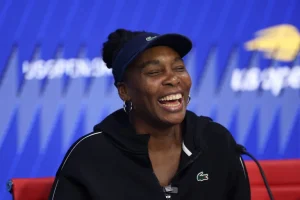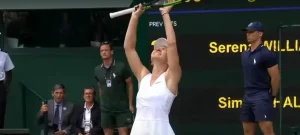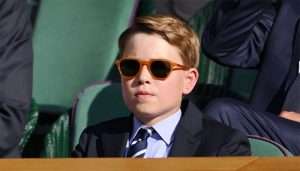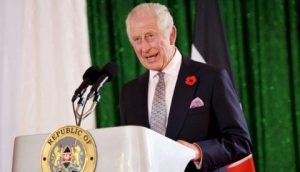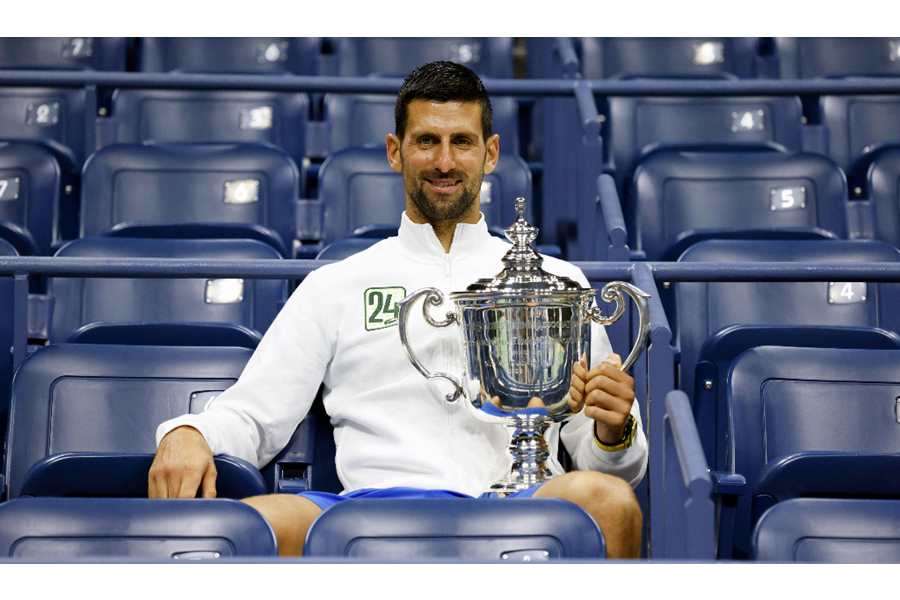
Novak Djokovic has had one of the finest seasons of his unparalleled career in 2023, but is this the greatest year the 24-time Grand Slam champion has ever had?
The 36-year-old added a seventh title of 2023 with his victory at the ATP Finals last week and recently secured a record-extending eighth ATP year-end world No 1 finish.
The Serbian could yet make it an even stronger year if he leads Serbia to glory in the Davis Cup, with the Final 8 stage of the team competition being contested this week.
Brad Gilbert, an elite coach and former world No 4, recently suggested we are witnessing the best season by any player since the ATP Rankings were established in 1973.
“This is 50th year of [the] ATP Tour. ‘Djoker’, his amazing eighth number one finish, 27-1 in Slams, missed 4 hard-court [Masters] 1000’s, hasn’t lost before finals since May, at 36 years young I will put this as best year potentially on men’s tour in 50 years,” wrote the American in a post on Twitter.
Speaking at the ATP Finals in Turin last week, Djokovic recognised he was having one of his greatest years, but stopped short of ranking it at the very top.
“One of the best years. I wouldn’t say the best, but one of the best. I mean, the fact that I’ve won three out of four Slams and played a final [in] the fourth and it’s still not the best year of my life, it’s quite nice to have that kind of situation (smiling),” he assessed in a press conference.
“It’s definitely one of the best seasons. I mean, I had couple of years, I think three [other] times, that I won three out of four Slams in a season, like 2011, 2015. In those years, I won more matches. I mean, I played more tournaments. I was really, I mean, feeling very dominant on the tour.”
Here, we look at how Djokovic’s 2023 campaign stacks up against his 2011 and 2015 seasons.
2011 – The winning streak and dominance of rivals
Heading into 2011, Djokovic had won one Grand Slam title, which came at the 2008 Australian Open. He had, though, made a positive finish to 2010 – reaching the US Open final in September, winning Beijing in October, making the Basel final in November, and leading Serbia to their only Davis Cup title in December.
Djokovic won his first 41 matches of the year, claiming seven titles in the process, as he constructed one of the most incredible streaks in tennis history.
The Serbian kicked off his season by winning the Australian Open for the loss of a single set, after claiming straight-set triumphs over Roger Federer and Andy Murray in the semi-finals and final. He added the ATP 500 title in Dubai, where he beat Federer in the final.
Djokovic then completed the ‘Sunshine Double’ by winning the back-to-back Masters 1000 events in Indian Wells and Miami. In Indian Wells, he overcame Federer in the last four and Rafael Nadal in the final, before downing the Spaniard again in the Miami title match.
After adding the Serbia Open 250 title, Djokovic secured consecutive clay-court Masters 1000 crowns in Madrid and Rome, earning his first win on the surface against Nadal in the final of the former. He edged Murray in an epic last four clash at the Italian Open and delivered another stunning straight-set win over Nadal in the final.
The Serbian’s devastating run came to an end when he lost his first match of 2011 in to Roger Federer in four sets in the semi-finals of the French Open in June.
He bounced back by winning his maiden Wimbledon title in a run which saw him become world No 1 for the first time by overtaking Nadal, who he saw off in a four-set final. Djokovic then won the Canadian Open in Montreal, before finishing as a runner-up in Cincinnati, where he retired through injury against Murray.
The world No 1 took his season to new heights by collecting a third Grand Slam title with his victory at the US Open, where he overcame his two biggest rivals in consecutive matches.
In the semi-finals against Federer, Djokovic famously recovered from 0-2 down in sets – and saved two match points at 3-5, 15-40 in the fifth set – to prevail. In the championship match, he outlasted Nadal in four brutal sets to claim his first US Open crown.
Djokovic’s triumph at Flushing Meadows was his 10th and final title of the year, with his relentless first two-thirds of the season understandably catching up with him physically in the latter stages as he lost four of his last 10 matches.
The Serbian ended the year with a stunning 70–6 (92.1%) record. He dominated Nadal (6-0), Federer (4-1) and Murray (2-1) – who were all at a high level, and was 21-4 (84%) against top 10 opposition.
2015 – Big title monopoly and unrivalled consistency
Following 2011, Djokovic won one Grand Slam title in each of the next three seasons, but he arguably surpassed his previous best season in 2015.
After a quarter-final exit in Doha, Djokovic triumphed at the Australian Open with a five-set semi-final win over Stan Wawrinka and a four-set final victory against Murray. He was then beaten in the final of the Dubai Championships by Federer.
The Serbian sealed a ‘Sunshine Double’, downing Murray and Federer in his last two matches in Indian Wells, before overcoming the Brit again in the Miami title match.
Djokovic then started his clay-court season by winning the Monte Carlo Masters, where he saw off Nadal in the semi-finals and Tomas Berdych in the final.
The world No 1 skipped the Madrid Masters to rest ahead of the Italian Open, where he claimed a fourth consecutive Masters 1000 triumph with wins over Kei Nishikori, David Ferrer and Federer in the final three rounds.
At the French Open, Djokovic stretched his winning streak to 28 matches following a stunning straight-set quarter-final victory against Nadal, and a five-set semi-final win over Murray. His sublime run ended with a four-set loss to Wawrinka in the championship match, with the Swiss producing an incredible display.
As in 2011, Djokovic responded to a tough, streak-ending Roland Garros defeat by prevailing at Wimbledon, where he defeated Federer in a four-set final.
The Serbian was then a runner-up at both of the hard-court North American Masters 1000 tournaments in Montreal and Cincinnati – losing to Murray and Federer in the respective finals.
At the US Open, he overcame Federer in four sets in a repeat of the Wimbledon final to secure a third Grand Slam title in a season for the second time following 2011.
Unlike four years prior, Djokovic maintained and even elevated his form after the year’s last Major – starting with him tearing through the China Open ATP 500 for the loss of just 18 games in five matches, including a final victory against Nadal.
The world No 1 made it a Chinese double by winning the Shanghai Masters without losing a set the next week, with triumphs over Murray and Jo-Wilfried Tsonga in the last two rounds.
Djokovic dropped a single set as he added the Paris Masters crown – downing top-five trio Berdych, Wawrinka and Murray in his final three matches.
The Serbian saw a 23-match winning run stopped by Federer in the group stage of the ATP Finals in London, but gained his revenge in straight sets in a final rematch, having defeated Nadal in the semi-finals.
He lost just three sets in his last 20 matches of the year as he finished with a breathtaking 82–6 (93.2%) record. Djokovic won 11 titles and reached the final or triumphed at every big event (Grand Slams, ATP Finals and Masters 1000) he entered.
Djokovic mastered his four biggest rivals: Federer (5-3), Nadal (4-0), Murray (6-1) and Wawrinka (3-1). He was also 31-5 (86.1%) against top 10 players.
2023 – An incredible showcase of longevity
Djokovic won three Majors again during a superb 2021 season in which he was one win away from completing a Calendar Slam, but his 2023 campaign has been more complete.
The Serbian started this year by winning the ATP 250 event in Adelaide with three-set wins over Daniil Medvedev and Sebastian Korda in the semi-finals and final respectively.
Djokovic battled through a hamstring issue to triumph at the Australian Open for the loss of just a single set, downing Stefanos Tsitsipas in a straight-set title match to claim an incredible 10th title at the event. He then lost in the last four in Dubai to Medvedev, before missing Indian Wells and Miami due to US vaccine entry requirements.
He returned in the clay-court season, where he suffered a third round exit to Lorenzo Musetti in Monte Carlo, a quarter-final defeat to Dusan Lajovic in Banja Luka, and a last eight loss to Holger Rune in Rome.
Despite a challenging build-up, Djokovic prevailed at the French Open, earning a four-set semi-final win over Carlos Alcaraz and a straight-set final victory over Casper Ruud.
At Wimbledon, Djokovic saw his 34-match winning streak at the All England Club ended by a defeat to Alcaraz in a pulsating five-set final that stopped his Calendar Slam hopes.
The Serbian next appeared at the Cincinnati Masters, where he saved a match point en route to downing Alcaraz in the final in a thrilling rematch of their previous encounter.
Djokovic then triumphed at the US Open with a straight-set win over Daniil Medvedev in the championship match to make 2023 the fourth three-Slam season of his career – a men’s record.
The world No 1, who had turned 36 in May, skipped the Asian swing to rest for the end of the season, and triumphed at the Paris Masters on his return. He saw off Grigor Dimitrov in a straight-set final, after consecutive three-set battles against Tallon Griekspoor, Rune and Andrey Rublev.
At the ATP Finals in Turin, Djokovic crushed Alcaraz in the last four, before avenging a round-robin loss to Jannik Sinner with a comprehensive final victory.
Djokovic has won seven titles from just 12 tournaments played in 2023, with six of his triumphs coming at either Grand Slams, the ATP Finals, or Masters 1000 events.
Prior to the Davis Cup Finals, his record was an excellent 55-6 (90.2%). He has bettered Alcaraz (3-1), Medvedev (2-1) and Sinner (2-1), who make up the top four and have been his primary competitors, and is 17-4 (81%) against top 10 opponents.
T365 verdict
Djokovic’s 2023 season has been remarkable given his age and the ruthless efficiency he has displayed at the most important events. The level of play and continued development of his game has also been amazing to witness, with his serve, forehand and net-play better than ever this year.
While he can elevate the campaign further by adding the Davis Cup title, it would arguably still not match the two sensational seasons he had earlier in his career.
In 2011, Djokovic built a winning streak that may never be matched in terms of the level produced and quality of opposition faced. His 6-0 record against a prime Nadal, who was coming off the back of an all-time great season the previous year, was particularly staggering.
The Serbia’s 2015 season, though, was his most complete statistically: most wins (82), highest win percentage (93.2%), most wins over top 10 players (31), most overall titles (11) and most big titles (10).
Djokovic’s level of dominance at the biggest events and consistency throughout – he won or made the final at 15 of 16 tournaments entered – sets 2015 apart.
